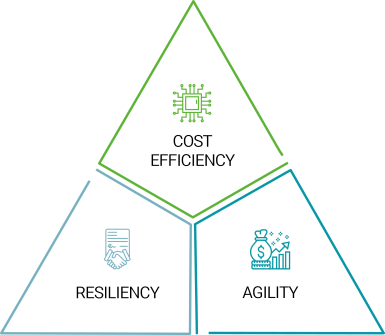
Mitigate complex supply chain risk and improve cost performance, when it really matters.

Businesses today face a steady stream of disruptions, including fast-evolving customer expectations, rapid technological advancement, changing trade regulations, and complex geopolitical landscapes. Rising costs require organizations to achieve savings without impacting business continuity.
How can business leaders balance the competing demands to manage costs while ensuring stable supplies and minimizing risk? With rapidly changing business conditions, harnessing technology to provide insight into these issues is critical.
AlixPartners’ Global Trade Optimizer™ (GTO) is a proprietary big data and analytics platform that helps companies to identify and mitigate global trade, sourcing, and supply-chain costs and risks.
We combine our vast data repositories with machine learning, artificial intelligence, and our institutional knowledge and expertise to identify opportunities for margin expansion and de-risk your global supply base.
GTO™ can offer 5-15% in COGS improvement with additional benefits in lost sales capture and working capital improvements, all within 4-6 months of execution support.
Trade is geopolitical and often volatile, making the terms, attractiveness, and viability of global supply chain sources dynamic.
Key Challenges:
Managing the impact of incoming US tariffs
- What’s the optimal way to reduce my exposure to incoming tariffs?
- How can I quickly evaluate my short-term and long-term options as tariffs shift?
Supply base overexposure to global shocks/risks
- What are the risks in my supply base?
- How do I assess and manage them?
Supply Chain diversification, Conundrum of ‘Diversify or nearshore’
- How is global trade shifting?
- How do I unlock diversification or nearshoring potential?
Margin management in inflationary environment
- How can I protect my margin?
- How do I stay ahead of the curve?
Leverage the power of big data and advanced analytics to solve complex global supply chain risk and disruptive challenges.
Our approach is focused on maximizing ROIC for your supply chain while building resiliency, agility and efficiency.

Cost efficiency
Increase margin and reduce COGS and direct material costs by: (a) optimizing supplier base; (b) evaluating make vs. buy options; (c) exploring increased scale and vertical integration for efficiency.
What GTO can do
Model-based analysis of gaps and opportunities leading to key margin and cost actions: (a) negotiate with existing vendors; (b) source new suppliers; and (c) redesign products to take advantage of lower-priced components.
Resiliency
Ability to address and mitigate disruptions in supply chain resulting from geopolitical, climate, financial, ESG, and other risk factors.
What GTO can do
Map the supply chain, identify risk factors across multiple tiers of suppliers, and mitigate risk through communication with existing suppliers to prevent incidents and sourcing new suppliers to build redundancy.
Agility
Redesign the supply chain to address market shifts, logistical challenges, customer expectations, and corporate strategic initiatives.
What GTO can do
Use competitive supply base intelligence to create a target supply chain baseline, and then generate and simulate different options to: (a) reduce cost; (b) optimize deliveries to customers; and (c) take advantage of local, regional, and national incentives.
Our track record:
- Millions in supply chain savings identified in a variety of sectors
- 5-15% spend savings typically realized on direct material costs.
Margin Optimization - Retail Industry
$2bn retailer, $50m in annual benefits delivered.
A retail client was experiencing margin compression due to inflationary pressure across multiple product categories. Leveraging GTO, we developed cost models for the SKUs being purchased by the client and worked with the client’s buyers to identify opportunities for cost efficiencies with vendors through margin risk alert, claw-back and other measures.
Cost Pressures - Packaging Industry
Using GTO and AI-enabled cost modeling to deliver $10M in annual benefits.
A subsidiary of this packaging business was facing supply chain challenges from product cost pressures. Using attributes and stock-tree regression, AI and machine learning was used to predict the right cost model for the business and identify the opportunity drivers. GTO enabled the team to find annual benefits equating to 15% of supply chain spend.
US Tariffs will upend global supply chains. Now is the time to prepare.
With a new administration coming to the White House, companies must adapt their strategies to the upcoming policy environment and how recently announced tariffs will shape global trade and supply chains.
10-25% general tariff
President-elect Trump campaigned on a call for a general tariff of 10 to 25% on all imports. U.S. administrations have multiple legal pathways to impose such tariffs.
Up to 60% tariffs on China
President-elect Trump's campaign called for 10 to 35% additional tariffs on goods imported from China on top of any general tariffs.
25% tariffs on Mexico and Canada
The incoming Trump administration recently stated they intend on implementing 25% tariffs on all imports from Mexico and Canada.
We’ve already seen how the tariffs imposed during the previous Trump administration significantly altered global trade dynamics, reshaping U.S. relations with key trading partners. This time, companies must proactively implement both short-term and long-term strategies to mitigate the impact of these upcoming tariffs and set themselves up for success in the coming years.
By leveraging diversified supply chains, renegotiating terms, and nearshoring, businesses can efficiently navigate the complex global trade environment while staying competitive. GTO helps our clients do all of those things better and faster.













